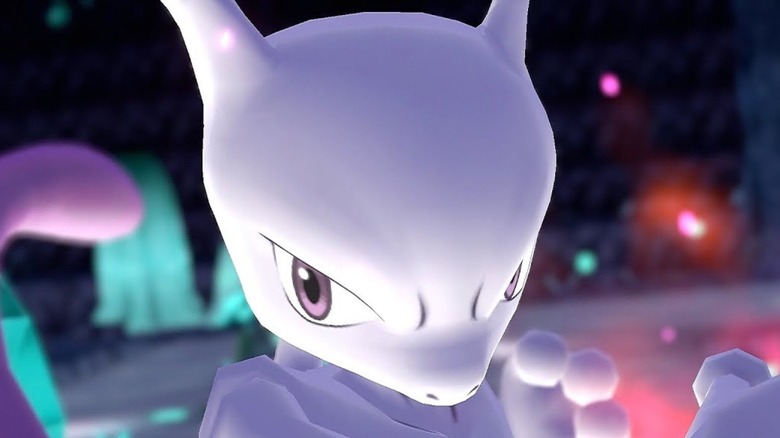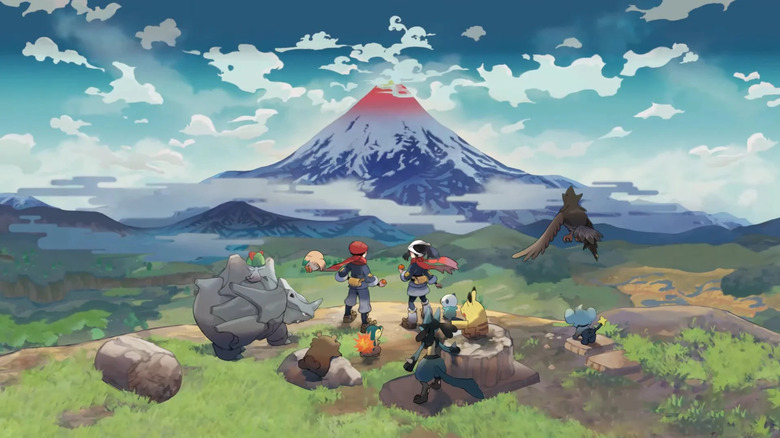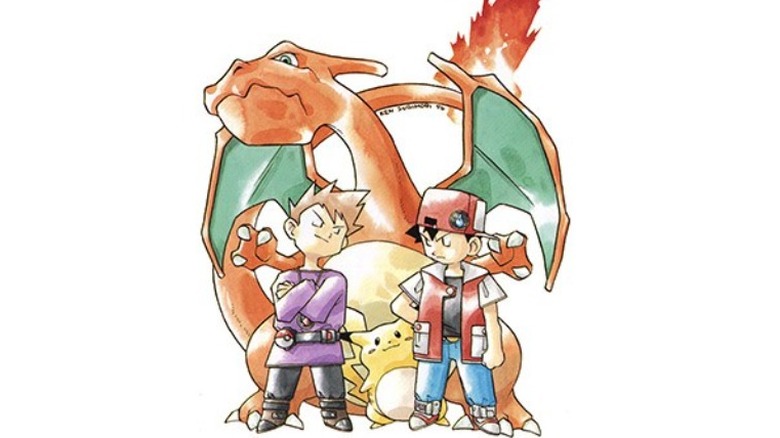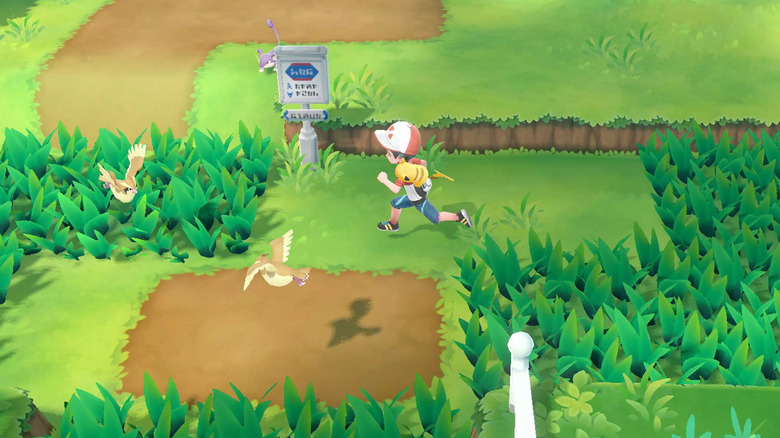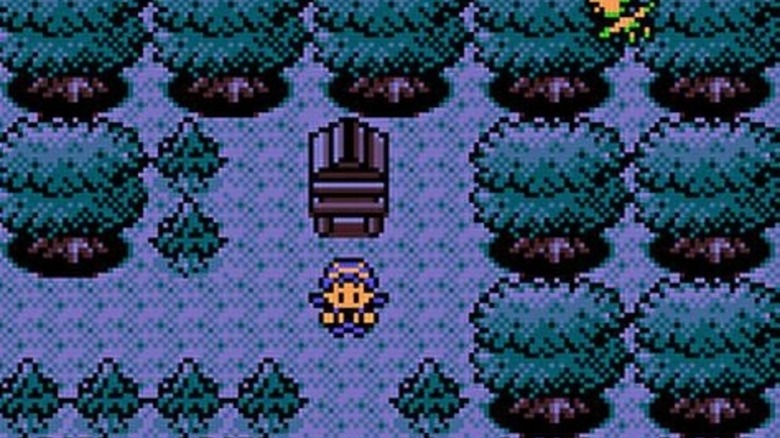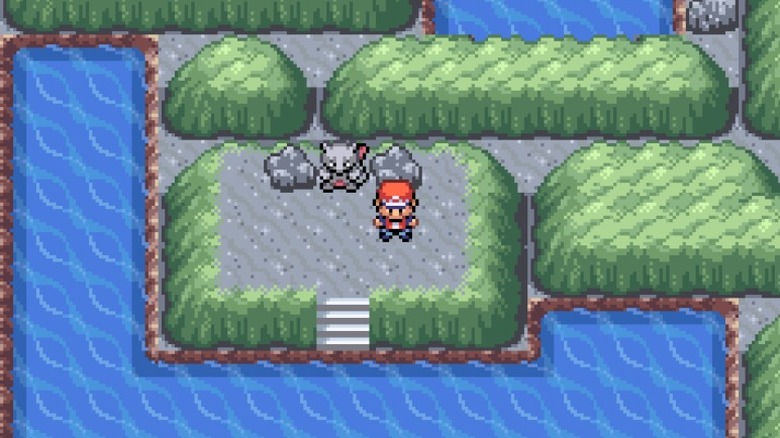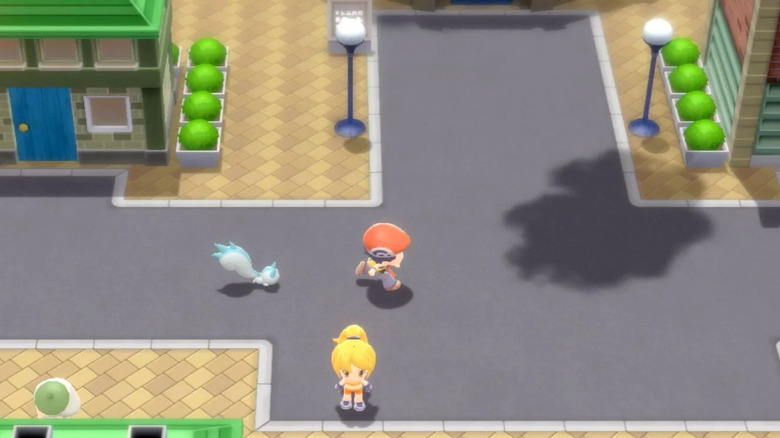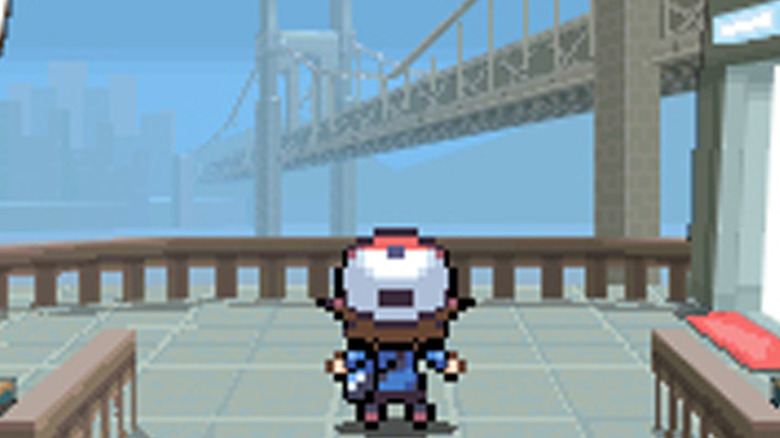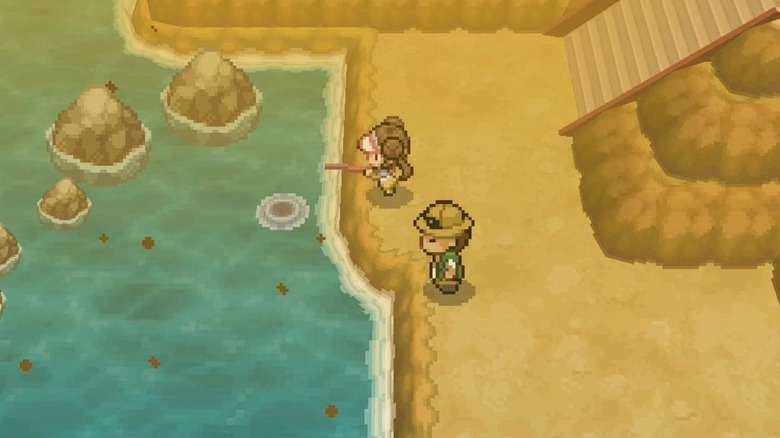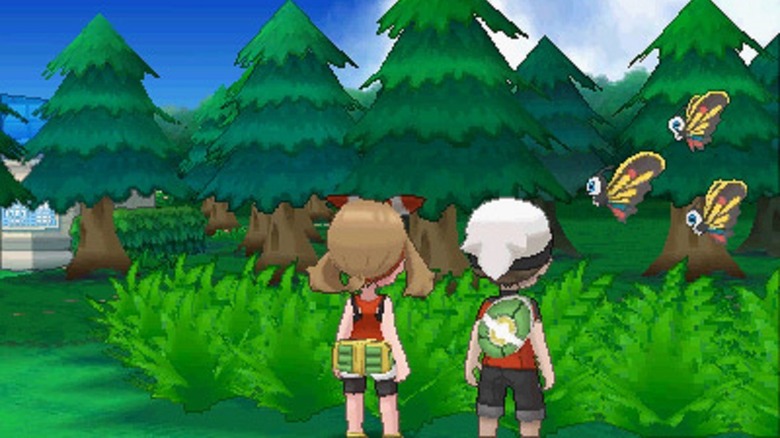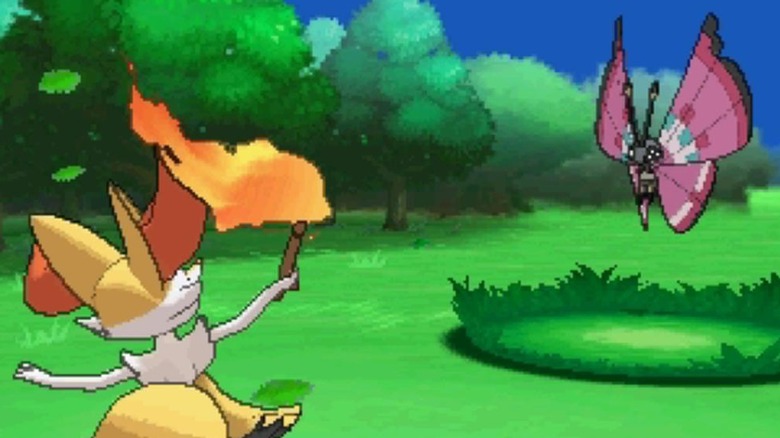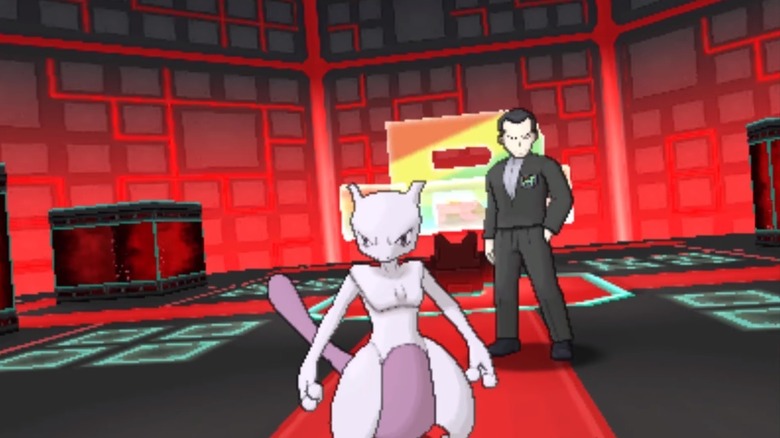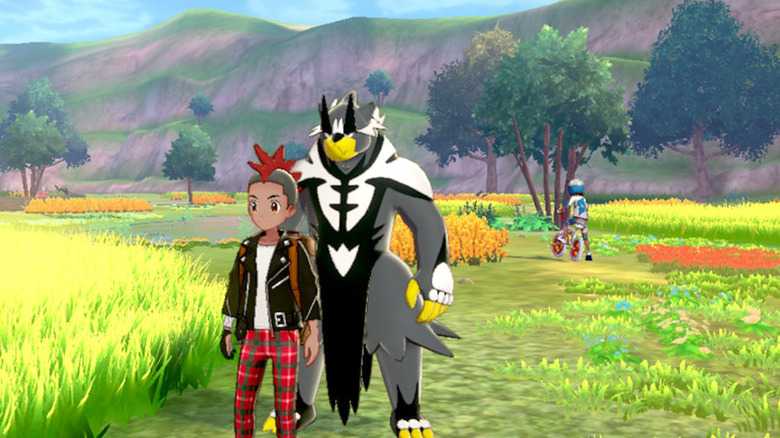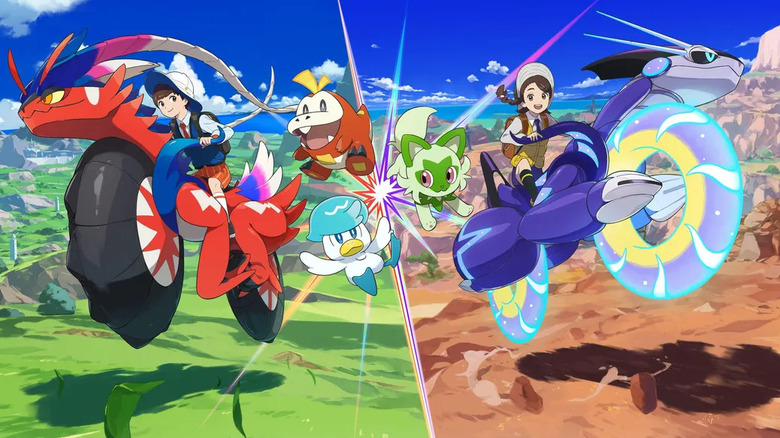The Entire Pokémon Timeline Explained
"Pokémon" is one of Nintendo's flagship franchises and has found its way into the hearts of countless players all across the world. As the series has gone on it has shown players new corners of its world and introduced hundreds of new creatures for players to find and capture. The mainline game series is also supported by various spin-offs like "Pokémon Snap," the mobile sensation "Pokémon GO," as well as other media, like the long-running anime series. While the anime follows the adventures of fledgling trainer Ash Ketchum, the games follow an entirely different story.
Most "Pokémon" games follow a similar story structure of a trainer getting their first Pokémon and embarking into the wider world to become a Pokémon Master, foiling the plans of evildoers along the way. However, the games can be arranged into a complicated web of timelines that is murky at best. To break things down — and keep all the various remakes/reboots/etc/ straight — we've arranged this into three distinct timelines covering the main installments of the series. If you've ever wondered exactly how the history of "Pokémon" ties together, here is the full timeline explained.
The Galaxy Expedition Team
The story of the Pokémon series starts with the Galaxy Expedition Team, introduced in "Pokémon Legends: Arceus." The game is set in the Hisui region around 300 years before any other title in the series. It sees players controlling a trainer sent back in time. While it is never explicitly stated, fans have pointed out that the characters do initially look like Dawn and Lucas, two characters that have appeared in the series elsewhere.
Once in Hisui, the player joins the Galaxy Expedition Team with the stated purpose of cataloguing all of the Pokémon in the region and learning how to tame them. The region's Pokémon are regarded as wild animals at the start of the game, similarly to how lions or bears are viewed in the real world. The player is tasked with completing their mission by both the Galaxy Expedition Team and Arceus, a god-like Pokémon believed to have created the universe.
As a reward for their work, players get to meet Arceus at the end of the game, by which time the fundamentals of the world of "Pokémon" are established and trainers start domesticating Pokémon. Despite its importance to the "Pokémon" canon, it is unclear which of the series' three timelines the game is meant to be set in. It instead seems likely that the game's story serves as a framework for the beginning of all three timelines or is set before the timelines diverged.
The Original Timeline begins with Red and Blue
The series' first timeline was naturally introduced with the very first games in the series, "Red," "Blue," and "Yellow." For clarity's sake, this will be referenced moving forward as the Original Timeline. All three of these games tell a variation of the same story. They all begin with two ten-year-olds named Red and Blue (a.k.a. Ash and Gary) who get their first Pokémon and become rivals for the title of Pokémon Master.
While doing so, the trainers also become involved in stopping the plans of a nefarious group of trainers calling themselves Team Rocket. Team Rocket aims to exploit Pokémon to make a fortune, preferably without having to work too much themselves. However, the player is never shown fully defeating Team Rocket, which is an important detail for a divergent timeline in the future. The early games in the series are also notable for allowing players to capture the elusive legendary Pokémon Mewtwo after completing its story.
As for the chronological placement of these games, the story fits best at the beginning due to the limited technology on display. This world's technology is still rather advanced, with notable examples including minor teleportation capabilities, the ability to store physical matter as digital data, and even cloning. However, these games don't feature more everyday technologies seen in future releases, such as smart phones, implying that those technologies haven't been developed yet.
The enigma of Let's Go!
The "Pokémon" series is no stranger to re-telling storylines in newer releases. This is great, because it allows players to revisit some of their favorite characters, regions, and sets of Pokémon. However, this practice does introduce a lot of questions regarding the series' timelines. One of the particularly confusing instances of this can be seen with "Pokémon Let's Go: Pikachu!" and "Pokémon Let's Go: Evee!"
In fact, the "Let's Go!" games don't really fit into any of the game's timelines. Both of the games tell a story that is almost identical to the events of "Yellow." They're both set in the same region as the first generation of games (Kanto) and feature the limited list of Pokémon native to it, and both games see players foiling the plans of Team Rocket. The game's place in the timeline is complicated, however, by the fact that players can meet older versions of Red and Blue, ruling out that the game is re-telling the same exact story.
To make things even more confusing, Blue references the adventures that he went on with Red when the player talks to him, implying that either they went on a different adventure that didn't involve beating Team Rocket — or that they defeated Team Rocket, only for the evil team to just reform afterward with the exact same plan. Whichever is true, these details seemingly prevent "Let's Go!" from comfortably taking place in any of the series' established timelines.
Gold, Silver, and Crystal
The Original Timeline was continued with the release of "Gold," "Silver," and "Crystal." Like the first three games in the series, all three of the second generation games share the same story, but grant access to different Legendary Pokémon. However, these games are confirmed to take place an unspecified number of years after the first games, because the new protagonist faces Red in a battle at the very end of the story. Throughout these second generation games, players also face off against a newly emboldened Team Rocket.
This time, Team Rocket is out for more than just money, and has instead concocted an idea to take over the world. Trying to rule a planet after not even being able to make a small fortune seems ill-advised, but it is far from the strangest thing ever attempted in "Pokémon Crystal."
Players also have the opportunity to catch new legendary Pokémon, including the Three Sacred Beasts, Ho-Oh, and Lugia. Unlike the stationary birds of the first generation, the Sacred Beasts will lead players on a hunt around the map, making the quest to catch 'em all more challenging than ever before.
The Main Timeline: Leaf Green and Fire Red
The second timeline in the series — which we'll call the Main Timeline — was established with the release of "Leaf Green" and "Fire Red." These two games largely focused on re-telling the story of the first generation, but with some notable additions that put it in its own timeline. Most obviously, players are able to play as a female character and a post-game questline was added that sees the player traveling to southern islands to seemingly defeat Team Rocket once and for all.
The Main Timeline was immediately continued with "Ruby," "Sapphire," and "Emerald," which follow Brendan and May on their journey to become Pokémon Masters. However, the story changes pretty drastically depending on which version is played.
In "Ruby," players face off against Team Magma, who wish to use the legendary Pokémon Groudon to dry up all the oceans in the world. In "Sapphire," players instead face Team Aqua, who want to use the legendary Pokémon Kyogre to flood the world and turn it into one giant ocean. Finally, "Emerald" sees trainers face off against both teams as the villains summon legendary Pokémon Groudon and Kyogre and have them fight, threatening to end the world. To stop them, the player enlists the help of the legendary Pokémon Rayquaza.
Diamond, Pearl, Platinum, Heart Gold, and Soul Silver
The Main Timeline was further expanded with the release of "Diamond," "Pearl," "Platinum," "Heart Gold," and "Soul Silver." In a now-deleted tweet from the game scenario writer at Game Freak, Toshinobu Matsumiya, it was seemingly confirmed that all five of these titles essentially take place at the same time in this version of events.
These games also appear to take place after "Ruby," "Sapphire," and "Emerald" because they introduce plenty of new technology to the world, including the player's Pokétch and the Global Trade System. Much like the timeline itself, the technology of the "Pokémon" universe is a subject of a lot of discussion for fans, but various advancements can be helpful when it comes to positioning games in their respective timelines.
In "Diamond," "Pearl," and "Platinum," players attempt to stop Team Galactic, who aim to use the legendaries Dialga and Palkia to destroy the universe so that it can be remade in a more perfect form. However, it should be noted that the "Brilliant Diamond" and "Shining Pearl" remakes don't fit perfectly into any timeline because of changes they introduced from the originals, such as the inclusion of the Fairy Type and some tech differences.
"Heart Gold" and "Soul Silver" re-tell the story of "Gold," "Silver," and "Crystal," but appear to do so in the Main Timeline, opening up some interesting comparisons between how the two timelines compare in their technological development.
Black and White
"Black" and "White" further continue the Main Timeline, likewise introducing new gadgets and technologies like cell phones, roller coasters, and C-Gear. Players control either Hilda or Hilbert (depending on their gender) as they start their journey to become Pokémon Masters.
Along the way, they also run into Team Plasma, a gang of criminals who will cause serious trust issues for invested gamers. When players first interact with Team Plasma, it seems that they are working to free all Pokémon from captivity so that they can live free and naturally. However, this ends up only being the goal of the team's leader, N. Toward the end of the game, N is betrayed by Team Plasma and it is revealed that they were merely using him to further their own goals of world domination.
While the player does beat Ghetsis, the secret leader of Team Plasma, they don't completely defeat the group, leaving the narrative open for the sequel.
Black 2 and White 2
"Black" and "White" were followed up with the direct sequels "Black 2" and "White 2" — a rarity in the franchise. The pair of games introduced players to two new trainers, Rosa and Nate, in a story set two years after the first "Black" and "White." Although they don't feature any new technology in the universe, players can run into familiar characters from the first game and see what they have been up to during the time gap. But more than the people have changed, as players are able to see how the legendary Pokémon of the proceeding game have changed the region around them.
Players also come across another plot from Team Plasma, which is making its resurgence. Team Plasma plots to separate Pokémon from humanity once again, believing the world's creatures would be better off without humanity exploiting them. This time around, the player is helped by Rood, one of Team Plasma's former sages, while the game's main antagonist is the sage Zinzolin, who has seized control of Team Plasma alongside Ghetsis.
The plot of "Black 2" and "White 2" follows some familiar beats, but it also builds on the legendary Pokémon at the center of the original. The story culminates in these powerful monsters fusing together into a new Pokémon that does the bidding of Team Plasma. Thankfully, through our heroes' combined efforts, the team is ultimately defeated for good.
The Mega Timeline makes big changes
This brings us to what could be considered the third "Pokémon" timeline: The Mega Timeline, which introduces the Mega Evolution ability. Mega Evolutions allow trainers to use a Key Stone with certain Pokémon, allowing them to temporarily transform into larger, more powerful versions of themselves for the remainder of a battle.
This mechanic is arguably significant enough to denote its own timeline because it is usable by Pokémon like Blastoise, Gengar, and Gyarados, all of which appeared in other games but couldn't undergo the Mega Evolution process. The earliest games set in this timeline are "Omega Ruby" and "Alpha Sapphire." These two titles largely retell the story of the original "Ruby" and "Sapphire," albeit with the inclusion of the new mechanic. "Omega Ruby" and "Alpha Sapphire" also include Fairy type Pokémon, which were not designated as such in the original games.
The game's strict adherence to the original titles' story, however, creates an interesting relation between the Main and Mega timelines. These remakes illustrate that the series' timelines can share almost identical storylines and events, despite having big changes to the world's technology, Pokémon abilities, and even entirely new types of Pokémon.
X and Y
The Mega Timeline also includes "Pokémon X" and "Y," in which players control either Serena or Calem, two nascent Pokémon tasked with exploring the Kalos region and learning more about Mega Evolutions. During their travels, the two frequently run into a man named Lysandre who talks to them about the beauty of nature and Pokémon in the wild. Lysandre seems innocent at first, but he is eventually revealed to be the leader of Team Flare, one of the most threatening evil gangs in "Pokémon" history. Team Flare seeks to eradicate all of humanity so that Pokémon can be the dominant species and enjoy undisturbed nature.
The player is able to defeat Team Flare, then moves on to collect the region's badges and challenge the Elite Four, much like trainers before them. Which seems like less of a big deal when all of mankind has just been saved from destruction, but these Pokémon Masters have some interesting priorities.
Ultra Sun and Ultra Moon
When "Sun" and "Moon" were initially released, it was unclear which timeline they belonged in. These games no longer featured Mega Evolutions, but instead introduced new Z-Moves. These powerful moves could be unleashed when a Pokémon and trainer combined all of their power together into one focused point. However, the games received upgraded versions that seemed to clear things up: "Ultra Sun" and "Ultra Moon." In these versions of the story, players are given access to Mega Evolutions after completing the game's storyline, which seems to firmly plant it in the Mega Timeline.
The games' story follows the protagonist through the new Alola region, where they battle against the light-stealing Team Skull. Toward the end of the game, players can also run into an older version of Red, who has finally come back from his self-imposed stay at Mt. Silver.
One of the most interesting parts of "Ultra Sun" and "Ultra Moon," however, is the addition of Team Rainbow Rocket. The remake features this team in a short questline after completing the game's main story. Interestingly, Rainbow Rocket is made up of an array of previous antagonists from throughout the series. When talking to members of this diabolical team (led by Team Rocket's Giovanni), they remark that many of them hail from different universes — an in-canon acknowledgement of the multiple timelines.
The uncertainty of Sword and Shield
"Sword" and "Shield" are both a bit difficult to place in one of the series' timelines. Neither game includes Mega Evolutions, but they do introduce the new mechanic of Dynamaxing. This phenomenon is another temporary transformation that allows trainers to make their Pokémon grow to massive size, increasing their strength and adding a new layer of spectacle to battles. However, throughout "Sword" and "Shield" it is explained that Dynamaxing is only possible in the Galar region due to the residual energy in its land. This means that the games could conceivably fit into any of the series' established timelines, or else they could have founded a new timeline that is defined by the ability to Dynamax.
Regardless of placement, the game's story follows the player's journey across Galar to stop Team Yell and again become a Pokémon Master. Team Yell has a plan to re-create an apocalyptic event in Galar's history known as the Darkest Day, which will replenish the Dynamax energy in Galar. The player is ultimately able to stop them with some old-fashioned Pokémon battles.
"Sword" and "Shield" also received two expansions after their release: "The Isle of Armor" and "The Crown Tundra." The first DLC saw players traveling to a new island to participate in a tournament at a place called the Master Dojo. "The Crown Tundra," on the other hand, follows a journey to a frozen area, expanding the world and lore of the Galar region even further.
Scarlet and Violet tie things together
Much like "Sword" and "Shield," 2022's "Pokémon Scarlet" and "Violet" don't have a blatant ties to any of the timelines, but they do have some hidden elements that can help fans place it. The generation's story is also unique in that it contains three distinct storylines. One sees the player character attending the region's Academy and countering Team Star. Another storyline focuses on the player character's efforts to track down ancient and powerful Pokémon, while the final story thread is concerned with the typical hunt for gym badges to become a Pokémon Master.
When it comes to the game's connections to the wider franchise, however, players need to pay attention to the small details of the game. Firstly, the story in Paldea seems to be set in the timeline that features Mega Evolutions, judging by the Pokédex entry for the Paradox Pokémon Roaring Moon in "Violet." The description draws a connection between the Paradox Pokémon's appearance and that of a Mega Evolved Salamence, so Mega Evolutions have to be known in the world of "Scarlet" and "Violet."
However, the games also connect to the history of "Sword" and "Shield," since players can find a book written at the end of the previous generation in the Academy's library. This helps place "Sword" and "Shield" in the same timeline, which is a massive discovery for timeline sticklers, since those games didn't place themselves in the timeline very well on their own.
Of course, as the "Pokémon" continues to evolve (pun totally intended), fans can look forward to plenty of new revelations about the timeline and lore.

